Marketing Design and Innovation: Competitive Advantage Report Analysis
VerifiedAdded on 2021/06/14
|5
|1053
|35
Report
AI Summary
This report delves into the intertwined concepts of marketing innovation and strategic competitive advantage, highlighting their significance in business growth and customer attraction. It defines marketing innovation as novel, impactful marketing strategies, and strategic competitive advantage as the edge a company gains over rivals through various means. The report emphasizes the benefits of these elements, using examples like Coca-Cola's 'One Brand' strategy. It explores the 4Ps of innovation (Product, Position, Process, Paradigm) and their application, particularly in the context of sustainability and packaging innovation. The conclusion reinforces the integral role of marketing innovation and competitive advantage in shaping successful business strategies. The report also includes a list of references for further reading.
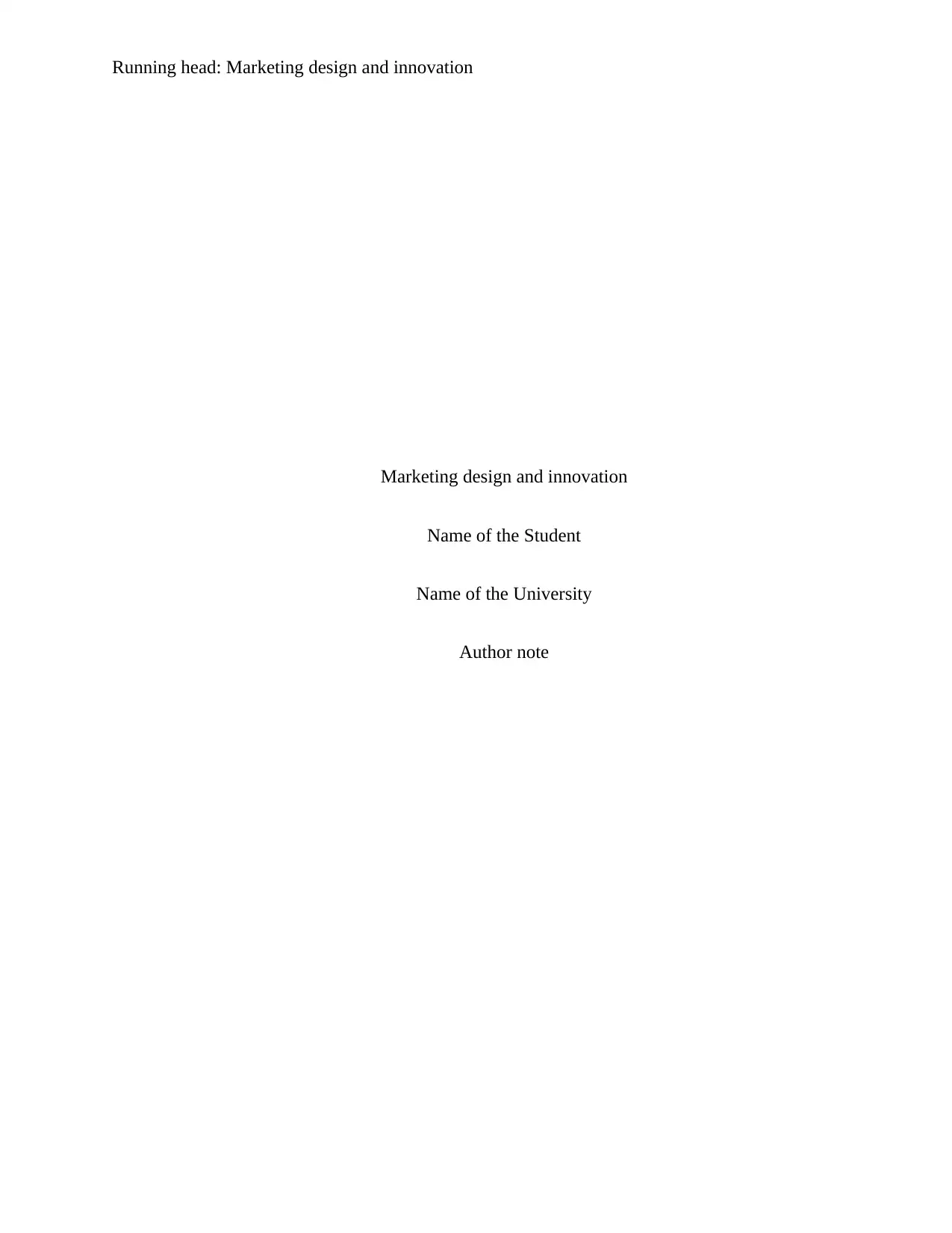
Running head: Marketing design and innovation
Marketing design and innovation
Name of the Student
Name of the University
Author note
Marketing design and innovation
Name of the Student
Name of the University
Author note
Paraphrase This Document
Need a fresh take? Get an instant paraphrase of this document with our AI Paraphraser
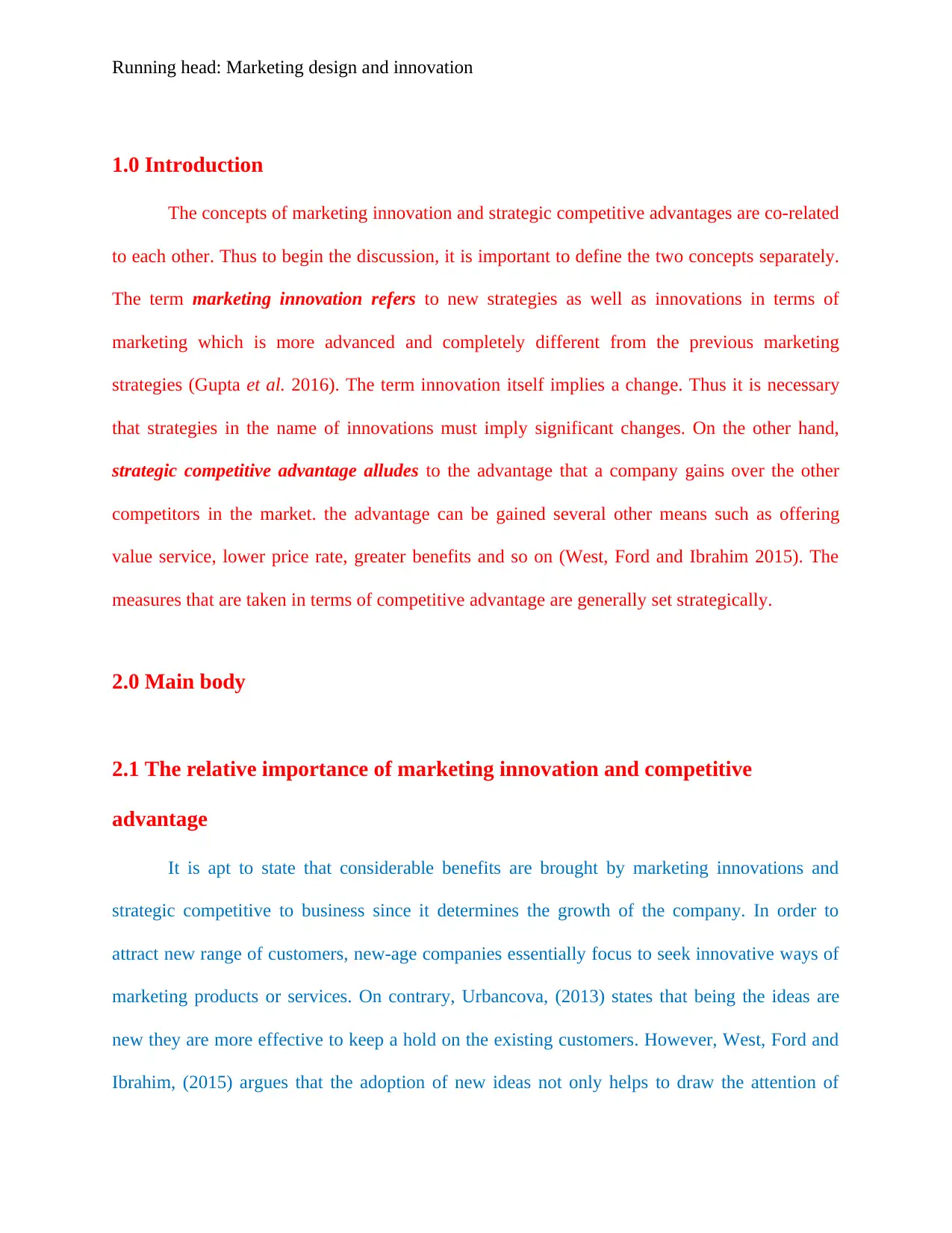
Running head: Marketing design and innovation
1.0 Introduction
The concepts of marketing innovation and strategic competitive advantages are co-related
to each other. Thus to begin the discussion, it is important to define the two concepts separately.
The term marketing innovation refers to new strategies as well as innovations in terms of
marketing which is more advanced and completely different from the previous marketing
strategies (Gupta et al. 2016). The term innovation itself implies a change. Thus it is necessary
that strategies in the name of innovations must imply significant changes. On the other hand,
strategic competitive advantage alludes to the advantage that a company gains over the other
competitors in the market. the advantage can be gained several other means such as offering
value service, lower price rate, greater benefits and so on (West, Ford and Ibrahim 2015). The
measures that are taken in terms of competitive advantage are generally set strategically.
2.0 Main body
2.1 The relative importance of marketing innovation and competitive
advantage
It is apt to state that considerable benefits are brought by marketing innovations and
strategic competitive to business since it determines the growth of the company. In order to
attract new range of customers, new-age companies essentially focus to seek innovative ways of
marketing products or services. On contrary, Urbancova, (2013) states that being the ideas are
new they are more effective to keep a hold on the existing customers. However, West, Ford and
Ibrahim, (2015) argues that the adoption of new ideas not only helps to draw the attention of
1.0 Introduction
The concepts of marketing innovation and strategic competitive advantages are co-related
to each other. Thus to begin the discussion, it is important to define the two concepts separately.
The term marketing innovation refers to new strategies as well as innovations in terms of
marketing which is more advanced and completely different from the previous marketing
strategies (Gupta et al. 2016). The term innovation itself implies a change. Thus it is necessary
that strategies in the name of innovations must imply significant changes. On the other hand,
strategic competitive advantage alludes to the advantage that a company gains over the other
competitors in the market. the advantage can be gained several other means such as offering
value service, lower price rate, greater benefits and so on (West, Ford and Ibrahim 2015). The
measures that are taken in terms of competitive advantage are generally set strategically.
2.0 Main body
2.1 The relative importance of marketing innovation and competitive
advantage
It is apt to state that considerable benefits are brought by marketing innovations and
strategic competitive to business since it determines the growth of the company. In order to
attract new range of customers, new-age companies essentially focus to seek innovative ways of
marketing products or services. On contrary, Urbancova, (2013) states that being the ideas are
new they are more effective to keep a hold on the existing customers. However, West, Ford and
Ibrahim, (2015) argues that the adoption of new ideas not only helps to draw the attention of
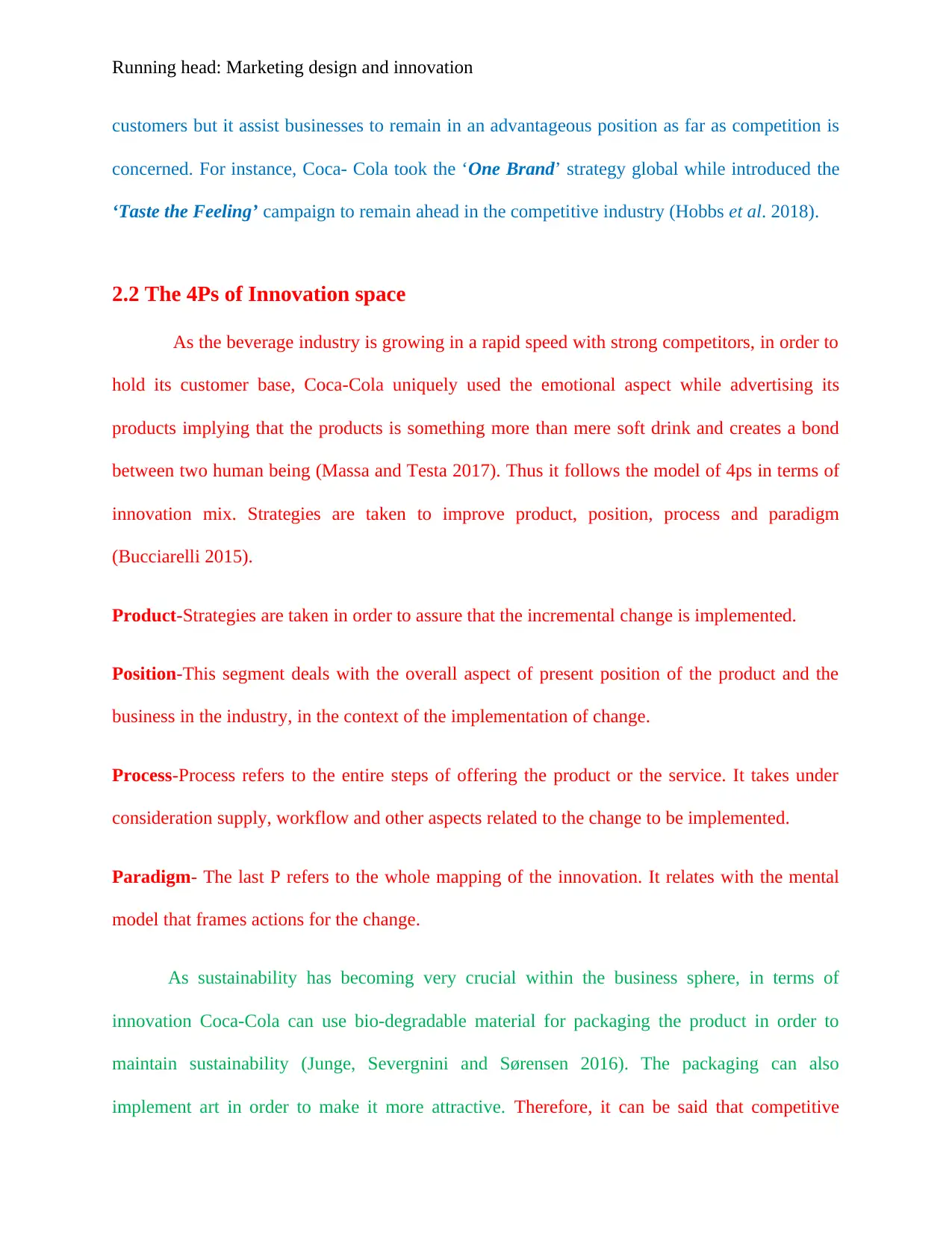
Running head: Marketing design and innovation
customers but it assist businesses to remain in an advantageous position as far as competition is
concerned. For instance, Coca- Cola took the ‘One Brand’ strategy global while introduced the
‘Taste the Feeling’ campaign to remain ahead in the competitive industry (Hobbs et al. 2018).
2.2 The 4Ps of Innovation space
As the beverage industry is growing in a rapid speed with strong competitors, in order to
hold its customer base, Coca-Cola uniquely used the emotional aspect while advertising its
products implying that the products is something more than mere soft drink and creates a bond
between two human being (Massa and Testa 2017). Thus it follows the model of 4ps in terms of
innovation mix. Strategies are taken to improve product, position, process and paradigm
(Bucciarelli 2015).
Product-Strategies are taken in order to assure that the incremental change is implemented.
Position-This segment deals with the overall aspect of present position of the product and the
business in the industry, in the context of the implementation of change.
Process-Process refers to the entire steps of offering the product or the service. It takes under
consideration supply, workflow and other aspects related to the change to be implemented.
Paradigm- The last P refers to the whole mapping of the innovation. It relates with the mental
model that frames actions for the change.
As sustainability has becoming very crucial within the business sphere, in terms of
innovation Coca-Cola can use bio-degradable material for packaging the product in order to
maintain sustainability (Junge, Severgnini and Sørensen 2016). The packaging can also
implement art in order to make it more attractive. Therefore, it can be said that competitive
customers but it assist businesses to remain in an advantageous position as far as competition is
concerned. For instance, Coca- Cola took the ‘One Brand’ strategy global while introduced the
‘Taste the Feeling’ campaign to remain ahead in the competitive industry (Hobbs et al. 2018).
2.2 The 4Ps of Innovation space
As the beverage industry is growing in a rapid speed with strong competitors, in order to
hold its customer base, Coca-Cola uniquely used the emotional aspect while advertising its
products implying that the products is something more than mere soft drink and creates a bond
between two human being (Massa and Testa 2017). Thus it follows the model of 4ps in terms of
innovation mix. Strategies are taken to improve product, position, process and paradigm
(Bucciarelli 2015).
Product-Strategies are taken in order to assure that the incremental change is implemented.
Position-This segment deals with the overall aspect of present position of the product and the
business in the industry, in the context of the implementation of change.
Process-Process refers to the entire steps of offering the product or the service. It takes under
consideration supply, workflow and other aspects related to the change to be implemented.
Paradigm- The last P refers to the whole mapping of the innovation. It relates with the mental
model that frames actions for the change.
As sustainability has becoming very crucial within the business sphere, in terms of
innovation Coca-Cola can use bio-degradable material for packaging the product in order to
maintain sustainability (Junge, Severgnini and Sørensen 2016). The packaging can also
implement art in order to make it more attractive. Therefore, it can be said that competitive
⊘ This is a preview!⊘
Do you want full access?
Subscribe today to unlock all pages.

Trusted by 1+ million students worldwide
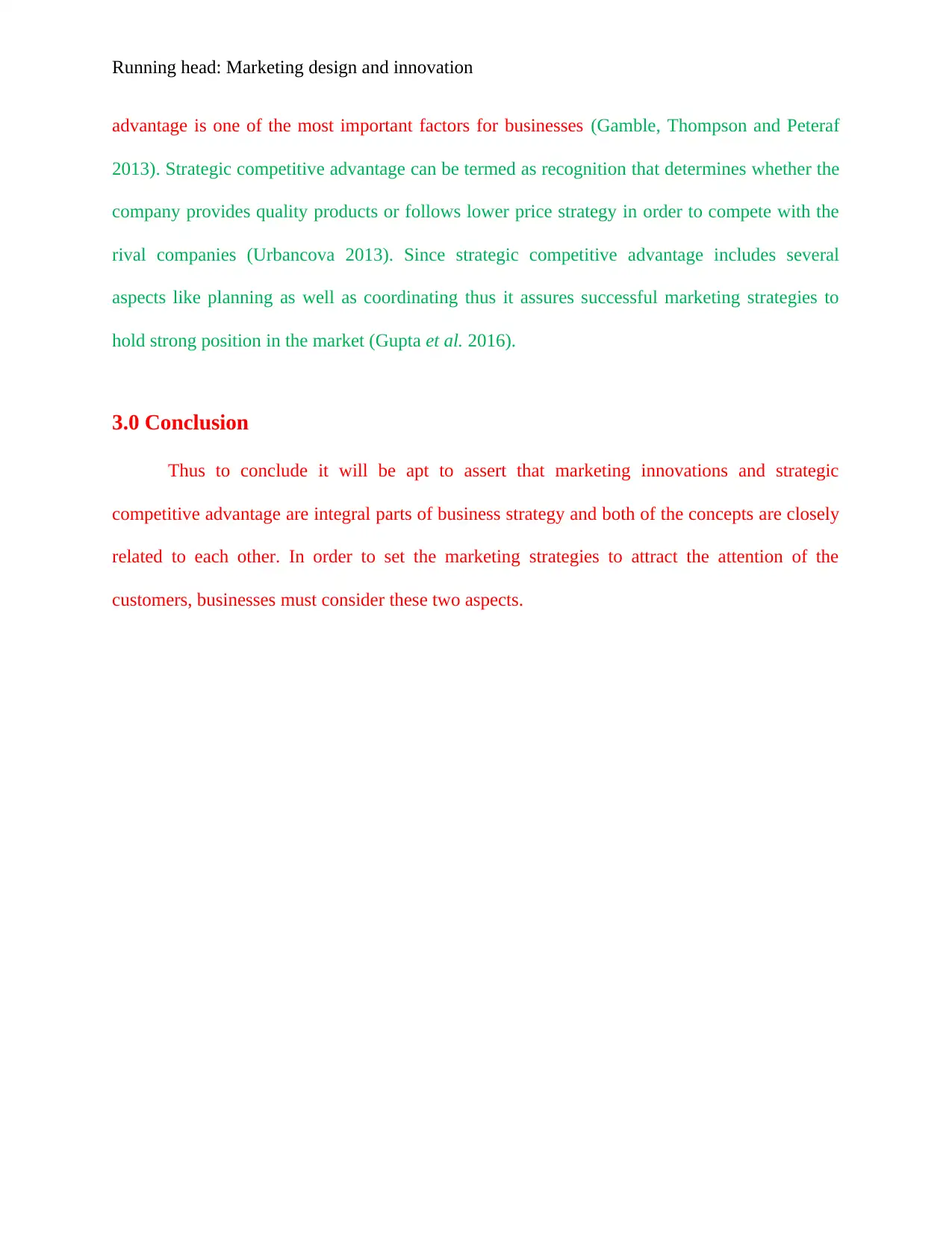
Running head: Marketing design and innovation
advantage is one of the most important factors for businesses (Gamble, Thompson and Peteraf
2013). Strategic competitive advantage can be termed as recognition that determines whether the
company provides quality products or follows lower price strategy in order to compete with the
rival companies (Urbancova 2013). Since strategic competitive advantage includes several
aspects like planning as well as coordinating thus it assures successful marketing strategies to
hold strong position in the market (Gupta et al. 2016).
3.0 Conclusion
Thus to conclude it will be apt to assert that marketing innovations and strategic
competitive advantage are integral parts of business strategy and both of the concepts are closely
related to each other. In order to set the marketing strategies to attract the attention of the
customers, businesses must consider these two aspects.
advantage is one of the most important factors for businesses (Gamble, Thompson and Peteraf
2013). Strategic competitive advantage can be termed as recognition that determines whether the
company provides quality products or follows lower price strategy in order to compete with the
rival companies (Urbancova 2013). Since strategic competitive advantage includes several
aspects like planning as well as coordinating thus it assures successful marketing strategies to
hold strong position in the market (Gupta et al. 2016).
3.0 Conclusion
Thus to conclude it will be apt to assert that marketing innovations and strategic
competitive advantage are integral parts of business strategy and both of the concepts are closely
related to each other. In order to set the marketing strategies to attract the attention of the
customers, businesses must consider these two aspects.
Paraphrase This Document
Need a fresh take? Get an instant paraphrase of this document with our AI Paraphraser
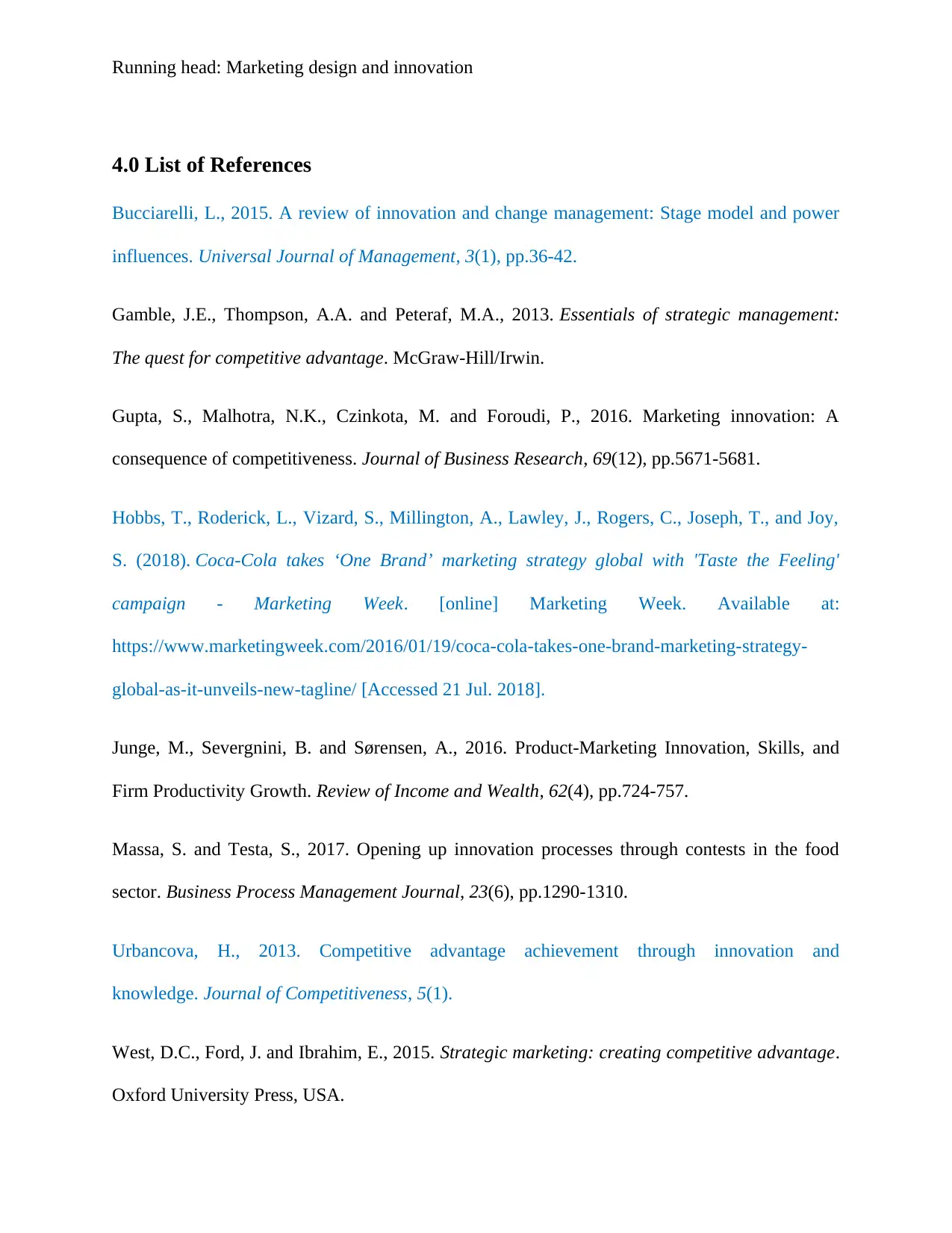
Running head: Marketing design and innovation
4.0 List of References
Bucciarelli, L., 2015. A review of innovation and change management: Stage model and power
influences. Universal Journal of Management, 3(1), pp.36-42.
Gamble, J.E., Thompson, A.A. and Peteraf, M.A., 2013. Essentials of strategic management:
The quest for competitive advantage. McGraw-Hill/Irwin.
Gupta, S., Malhotra, N.K., Czinkota, M. and Foroudi, P., 2016. Marketing innovation: A
consequence of competitiveness. Journal of Business Research, 69(12), pp.5671-5681.
Hobbs, T., Roderick, L., Vizard, S., Millington, A., Lawley, J., Rogers, C., Joseph, T., and Joy,
S. (2018). Coca-Cola takes ‘One Brand’ marketing strategy global with 'Taste the Feeling'
campaign - Marketing Week. [online] Marketing Week. Available at:
https://www.marketingweek.com/2016/01/19/coca-cola-takes-one-brand-marketing-strategy-
global-as-it-unveils-new-tagline/ [Accessed 21 Jul. 2018].
Junge, M., Severgnini, B. and Sørensen, A., 2016. Product‐Marketing Innovation, Skills, and
Firm Productivity Growth. Review of Income and Wealth, 62(4), pp.724-757.
Massa, S. and Testa, S., 2017. Opening up innovation processes through contests in the food
sector. Business Process Management Journal, 23(6), pp.1290-1310.
Urbancova, H., 2013. Competitive advantage achievement through innovation and
knowledge. Journal of Competitiveness, 5(1).
West, D.C., Ford, J. and Ibrahim, E., 2015. Strategic marketing: creating competitive advantage.
Oxford University Press, USA.
4.0 List of References
Bucciarelli, L., 2015. A review of innovation and change management: Stage model and power
influences. Universal Journal of Management, 3(1), pp.36-42.
Gamble, J.E., Thompson, A.A. and Peteraf, M.A., 2013. Essentials of strategic management:
The quest for competitive advantage. McGraw-Hill/Irwin.
Gupta, S., Malhotra, N.K., Czinkota, M. and Foroudi, P., 2016. Marketing innovation: A
consequence of competitiveness. Journal of Business Research, 69(12), pp.5671-5681.
Hobbs, T., Roderick, L., Vizard, S., Millington, A., Lawley, J., Rogers, C., Joseph, T., and Joy,
S. (2018). Coca-Cola takes ‘One Brand’ marketing strategy global with 'Taste the Feeling'
campaign - Marketing Week. [online] Marketing Week. Available at:
https://www.marketingweek.com/2016/01/19/coca-cola-takes-one-brand-marketing-strategy-
global-as-it-unveils-new-tagline/ [Accessed 21 Jul. 2018].
Junge, M., Severgnini, B. and Sørensen, A., 2016. Product‐Marketing Innovation, Skills, and
Firm Productivity Growth. Review of Income and Wealth, 62(4), pp.724-757.
Massa, S. and Testa, S., 2017. Opening up innovation processes through contests in the food
sector. Business Process Management Journal, 23(6), pp.1290-1310.
Urbancova, H., 2013. Competitive advantage achievement through innovation and
knowledge. Journal of Competitiveness, 5(1).
West, D.C., Ford, J. and Ibrahim, E., 2015. Strategic marketing: creating competitive advantage.
Oxford University Press, USA.
1 out of 5
Related Documents
Your All-in-One AI-Powered Toolkit for Academic Success.
+13062052269
info@desklib.com
Available 24*7 on WhatsApp / Email
![[object Object]](/_next/static/media/star-bottom.7253800d.svg)
Unlock your academic potential
Copyright © 2020–2025 A2Z Services. All Rights Reserved. Developed and managed by ZUCOL.





